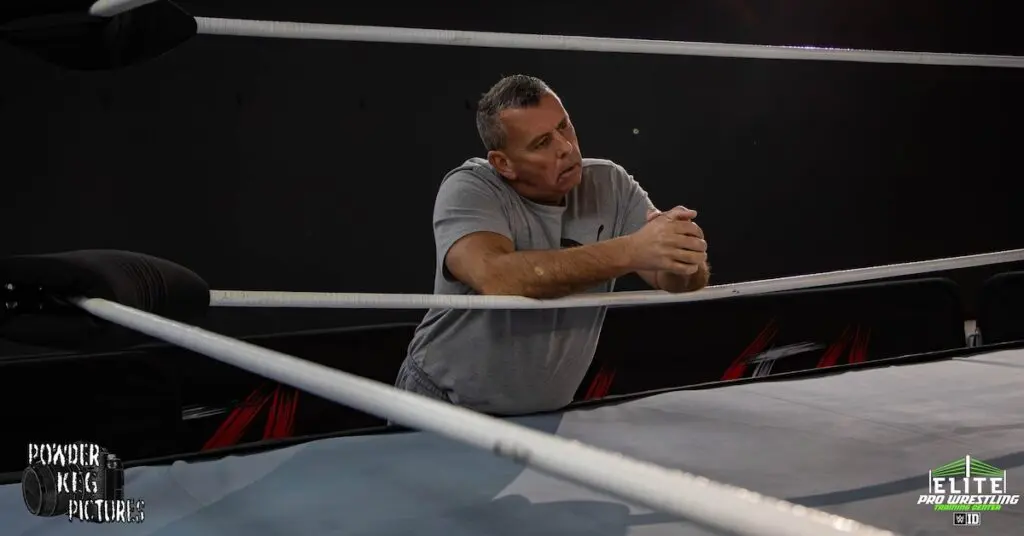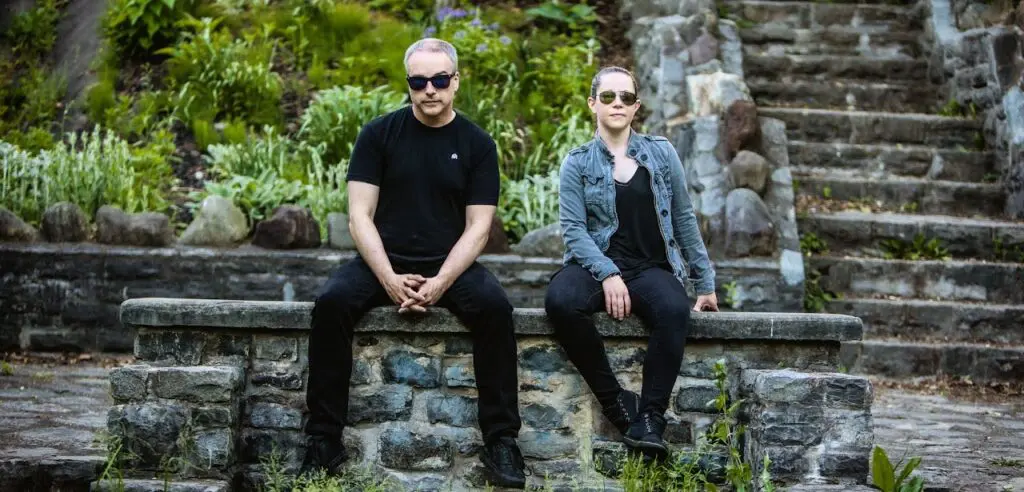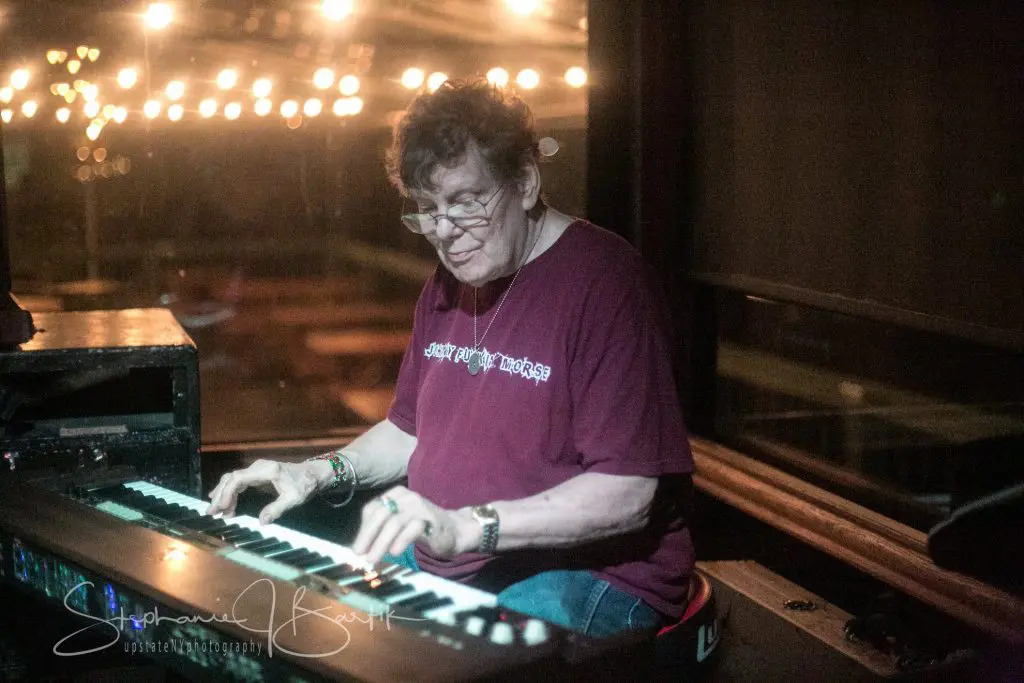Acoustic Trauma – Trauma is a State of Mind
By Staff on May 2, 2019
When I was jamming out, my sound stage wishes and wah pedal dreams in tow, I’d heard of Acoustic Trauma. I’d never seen them, but I’d heard a bootleg tape, so I knew what they were laying down. That was in the late 90s, and Acoustic Trauma has been laying it long since I laid my guitar to rest.
With Patrick McNulty on bass, Jason Ellenbogen on drums, and Paul Nunzio Maceli on… well, a little bit of everything else, Acoustic Trauma has been blowing minds from the cradle to the cap and gown.
I sit with Paul to mull over the finer points of interstellar traffic law.
RRX: You really push the envelope when it comes to an acoustic sound. In fact, I don’t think many people hearing you for the first time would have the word ‘acoustic’ as first choice – there’s so much more in the sound. When you started jamming out, maybe pre- ’97, did you see yourself as an acoustic set, or was that a crown given?
Paul: It’s actually an interesting story. To give you some background, my early influences included classic rock, mostly progressive rock and heavy metal. In my teen years, I quit playing music to go to college for business, knowing that the only way I would ever get back into music was if I was to do something original that no one else was doing. Fast-forward to my twenties, in the midst of trying to find a hobby better than my unhealthy barhopping, I was hanging out at my apartment with my Uncle Peter (bassist at the time of the funk rap band Shootyz Groove) showing off a 12-string acoustic guitar that I just purchased. I started banging away on it as if it was an electric guitar and he said to me “hey, you’re playing that thing like it’s an electric guitar! You’re not supposed to do that!” I asked “does it sound good?” and he said, “Yeah! It’s different!” So, that started the wheels moving in my head because in the 1990s, the only thing you heard from anyone with an acoustic guitar in their hand was an “unplugged” version of a rockin’ song or a sweet little folk tune that everyone already loved. No one was plugging an acoustic guitar into an amplifier and putting it through effect pedals and turning it up, let alone having the nerve to jump in front of a kick ass bass/drum rhythm section to blow people away. That sound was right up my alley!
That also happened to be around the same time that Eric Clapton had released the unplugged version of his energetic 70’s hit “Layla.” The electric version of “Layla” was one my favorite songs of all time and when I heard it all toned down and quiet, I wanted to puke into my shirt! Especially after what I felt I had just discovered about the energy of the acoustic guitar. “No! You can’t do that! You don’t have to sit down and ruin that song!” I thought to myself. Of course, I didn’t worry about it because I thought it would be a stinker, but lo and behold: it was a hit! In addition, it had become a trend and EVERYONE began unplugging their songs! Now I was on a mission to defy the masses and alas, in 1996, I was back playing music again. By 1998, I had incorporated the violin into the mix and then the mandolin. As of lately, I also whip out the MOOG Theremini (modeled after the MOOG Theremin) because it’s just so much fun! Plus it’s different. I mean, how many people do you see jamming on a Theremin on a rock and roll stage?
RRX: When I heard the instruments you all play, I would’ve expected an atmospheric kind of music, but that’s really not what you guys are laying down. Less a misty morning, more a tempest. Is that why you guys named yourselves Acoustic Trauma? Is it a cool name or a warning label?
Paul: Ha! It’s both! The name serves as a definitive pun because even though the lead instruments are acoustic, they are plugged into a powerful amplifier to keep up with the drums and electric bass guitar. It can get pretty loud and the term “acoustic trauma” describes damage done to the ear as a result of loud sounds. I thought it was pretty smart.
RRX: I have a good sense of what you’re playing in your songs, instrument-wise, but it’s a sense – I could be way off. I think anyone just hearing you on the radio or on their laptop or phone might want to know, so would you mind giving us a sneak peak of your ingredients list? What instruments go into an ‘Acoustic Trauma’ jambalaya?
Paul: The Acoustic Trauma Jambalaya consists of a drum kit (always played by a rockin’ drummer), a driving but funky bass guitar, and depending on the song, I am proud to be the chef that decides whether a violin, acoustic guitar, mandolin, and/or MOOG Theremini is the lead meat of the song. Sprinkle a little vocal expression over that and voila: the delicious power trio known as Acoustic Trauma!
RRX: AT has been on scene since ’97, so twenty-two years. So you’ve had a chance to see the local music scene evolve, and yourselves along with it. Have you all ever had to take a year or two off in all that time? Have you ever had a chance to be surprised by something happing to the 518 scene?
Paul: There is so much talent in the area, as well as people who are warriors of promoting the arts. Like the X, for example. What you guys are doing to support the independent arts is what keeps a scene like this going. It’s humbling and I know that we appreciate it! That’s the surprise: there are always people who care about and cherish artistic creativity. From venues to bars to special events to charities, there is a support for the local arts.
It has been an interesting journey throughout the years in the 518. When AT started, the big deal was making a CD and getting your songs played on the radio, even if it was just on the local half-hour show. We had radio stations supporting local bands and that was really cool. They made us feel like rock stars. Then there was the regional television show Sounding Board, which showcased a different local band each week. That was before YouTube, so it came with the excitement of performing in a television studio, as well as seeing yourself on TV. That was a wonderful support vehicle. Plus, I watched it all the time just to check out the other bands. Of course, there was Metroland Magazine, Times Union, and other publications that would write bands up, their CDs and live shows. It was like having our own local Rolling Stone and Village Voice and everyone wanted to be written up in there. But then the internet came along and changed everything. There are websites to show off music, photos and where we play out. We could get more exposure on YouTube and you can share whose videos on your social media, which is where most people are on these days. There is easy access to get music and information on a band now.
RRX: A long time ago, I heard about the Trauma House. Whispers, really, maybe legends when we kicked the bottom shelf stuff. You also have a live album from the Trauma House. So, the fire’s going, and the legend is yours to tell; what was, or is, the Trauma House?
Paul: The Trauma House is pretty much my house and Acoustic Trauma headquarters for practicing, writing, hanging and house parties, thus the name “The Trauma House.” At first I didn’t like the way the name rang but everyone seemed pretty comfortable calling it that after the first private party, so the name just stuck. We pretty much had our own live venue with full lights, fog, sound and people! Our friends and fans always came to those. It was wonderful! It became such an event, that we decided to record our live CD/DVD there. As for the “legendary” stuff…I’m saving that for the book. As of current, we had a party in 2018 and I am happy to say that if things line up they way we want, there will more of them.
RRX: I love music, but my day job is storyteller, and I just realized that I rarely ask people about their lyrics. I just get wrapped up in their sound when I’m writing out these questions. But I’m digging your lyrics. What would you say influences the direction of your lyrics, or the theme of them?
Paul: I mostly write about things that piss me off. I try to disguise the lyrics with sarcasm, cryptic poetry and sometimes the macabre to have some real fun with everyone. The songs are sort of like little bible stories where there may be a lesson to be learned or a joke to be told. The topics and themes are all over the place, while my main artistic focus in Acoustic Trauma is with the music.
RRX: This is where you get to answer any question I didn’t ask. Who do you love out there? What do you have coming up? Do you have a recipe for actual jambalaya? The floor is yours.
Paul: Currently we have a many fun creative projects in the mid-works. First, there’s the “new album.” We have some new songs recorded from the Trauma House basement studio. Those simply need some production decisions on what to keep and what to not to keep, while we’re still coming up with new ideas all the time. Second, we have several multi-track live recordings where we could easily release a live album consisting of extended-jam versions of our songs. We’ve turned our musical energies more into seeing what we can do “on the fly” live as opposed to just playing the songs as they are on the disc. Those have been a lot of fun and we are lucky to be able to pull it off. Lastly, we have incorporated a few cover tunes in the live set, mainly using the violin as the lead instrument as opposed to guitar. These include “Fire” (Jimi Hendrix), “YYZ” (Rush), “Jerry Was A Racecar Driver” (Primus) and “Ace of Spades” from Motorhead. Like seriously, who is playing Motorhead on the violin? Acoustic Trauma is, that’s who!
THIS FRIDAY JULY 26 2019 Dino BBQ TROY NIGHT OUT FREE SHOW WITH ACOUSTIC TRAUMA & THE COLLECTORS







 RadioRadioX
RadioRadioX